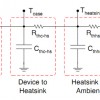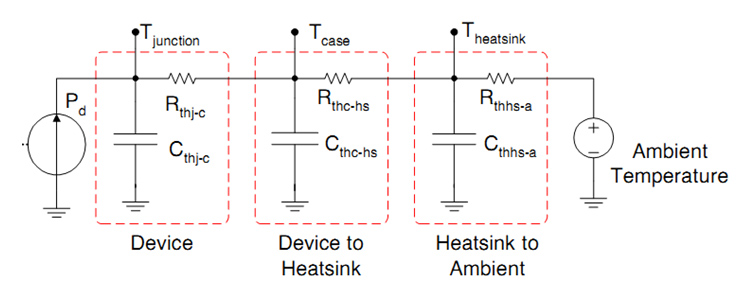Before the Heat Kicks in

Heat Sink Calculations
Today’s demanding applications require components and systems to work under intense environmental conditions. Survivability is critical, as features are only as good as their ability to operate without fail.
Innovation in thermal management has become essential to meeting the requirements for fault-free performance. The choice of an appropriate thermal management system depends on cost and development time of a product. The techniques for heat dissipation include heat sinks and fans for air cooling, liquid cooling and peltier cooling (Thermoelectric cooling) etc. Designing a cost competitive electronics system requires careful consideration of the thermal domain also. To find the most optimized solution requires a good understanding of thermal properties of devices and knowledge on how to remove unnecessary heat from the devices.
This article presents the basic properties and principles of the thermal system of a device and the method of selection of a heat sink to prevent overheating under normal operating conditions.
Thermal Property – Definitions
- TA – Temperature at reference point “A”
- TJ – Junction temperature, often assumed to be constant across the die surface
- TC or TCase – Package temperature at the interface between the package and its heat sink; should be the hottest spot on the package surface and is the dominant thermal path
- Theatsink – Temperature at heat sink
- PD – Power dissipation, source of heat flux (Watts)
- H – Heat flux, rate of heat flow across a unit area (J·m-2·s-1)
- RƟJMA – Junction to moving air ambient thermal resistance
- RƟchs – Case to heat sink thermal resistance
- RƟJC – Junction to case thermal resistance of a packaged component from the surface of its silicon to its thermal tab, or RƟJC
- RƟhs-a – Heat sink to ambient thermal resistance
- RƟJA – Junction to ambient thermal resistance
- CƟAB – Thermal capacitance between reference points “A” and “B”; A and B should be junction, case or heat sink
- °C or K – Degrees Celsius or degrees Kelvin
- CƟJC – Junction to case thermal capacitance
Thermal Circuit – Basic Principle
 |
| Figure 1: Thermal circuit |
Determining the Necessity of Heat Sink and Heat Sink Calculation
The following procedure provides a method one can use to determine whether a heat sink is required. This example uses a semiconductor device, with the condition listed below.
(1) Power – 20W, (2) Maximum TA – 50 °C, (3) Maximum TJ – 85 °C, (4) Air flow rate – 400 feet per minute, (5) ƟJA – 4.7 °C/W, (6) ƟJC – 0.13 °C/W.
| 1. | Using the junction temperature equation, calculate the junction temperature under the listed operational conditions: | |||||||||
| TJ = TA + P × ƟJA= 50 + 20 × 4.7 = 144 °CThe junction temperature of 144 °C is higher than the specified maximum junction temperature of 85 °C. So a heat sink is absolutely required to guarantee proper operation. | ||||||||||
| 2. | Using the heat-sink-to-ambient equation (and a ƟCS of 0.1 °C/W for typical thermal interface material), calculate the required heat-sink-to-ambient thermal resistance: | |||||||||
|
||||||||||
| 3. | Select a heat sink that meets the thermal resistance requirement of 1.52 °C/W. The heat sink must also physically fit onto the device. The thermal resistance of Z40-12.7B at an air flow of 400 feet per minute is 1.35 °C/W. Therefore, this heat sink will work since the published thermal resistance ƟSA is less than the required 1.52 °C/W. Using this heat sink, and re-verifying: | |||||||||
|
||||||||||
| 81.6 °C is under the specified maximum junction temperature of 85 °C. This justifies that the Z40-12.7B heat sink solution will work. |
Factors Affecting Cost Effective Thermal Management
- Selection of a good heat sink with higher heat sink to ambient thermal conductivity. Heat sink design and proper heat flow is the first and most critical factor in any thermal management design.
- Selection of a highly thermally conductive and void free interface material.
- Use of a very thin thermal interface material.
- Use of void free interface between the power device, interface material and the heat sink (or heat pipe).




No Comments